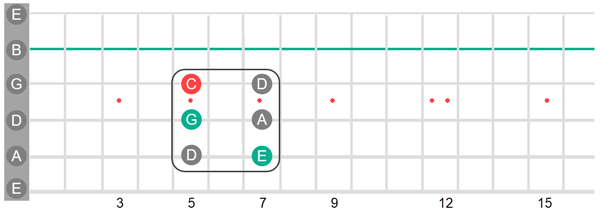Chord Chasing
So far we've used the major or minor pentatonic scale to solo over chord progressions. An alternative method, called chord chasing, targets the individual notes of each chord. Instead of playing the pentatonic scale, you focus your attention on the three or four notes that make up each chord. The C chord, for example, has three chord tones, C, E and G.

Chord tones harmonize better than non chord tones. The goal is to play the chord tones for each chord as they come up in a progression. Fortunately, chord tones are built into Freedom blocks making it relatively easy to target those notes.
Major Chord Tones
Major chords use the first, third and fifth degrees of the major scale. The G major chord tones are G, B and D.
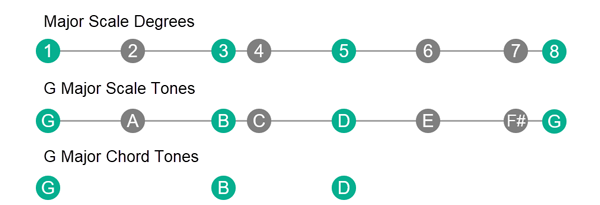
You can find the notes for any major or minor chord using these triangles. In a minor chord the 3rd degree is moved down one fret. It's called a minor 3rd or flat 3rd.
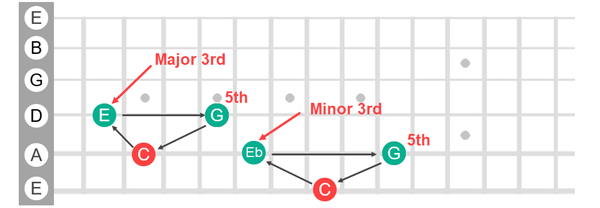
The first major pentatonic square (below) shows the scale degrees. The second square shows the chord tones and the third square shows what you need to remember. (Note: the fifth degree is always above the root except when the root lands on the B string.)

Getting Started Using Major Chord Tones
Our chord progression is G, C and D. Our plan of action is . . .
- Find the root of the major chord anywhere on the fretboard
- Surround it with a major pentatonic square
- Emphasize the chord tones
- Use non-chord tones as passing tones
- Move around using additional Freedom Blocks
The first chord in our progression is G. We'll use a G major square and emphasize the red and green chord tones. The emphasis can be frequency, duration, repetition, vibrato, or you looking up with a big smile everytime you play one.
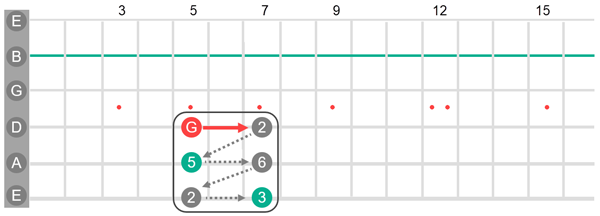
You could start on the low E string and continued all the way to the high E string using stepping squares. I've added row numbers so you can see that you're using more than one square.
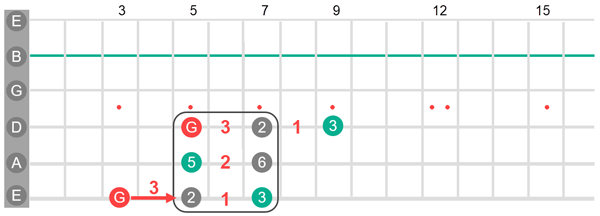
Before we go to our next chord, play the notes in this G major pentatonic square over this G major backing track. Compare how the chord tones harmonize verses the non chord tones.
(G MAJOR BACKING TRACK HERE)
Up until now you would have used that G major ptentatonic square for all the chords in the key of G. But now, when the progression changes to a C chord, you're going to switch to a C major pentatonic square.
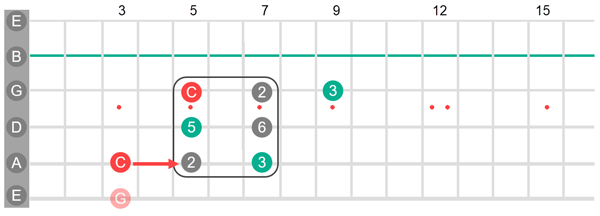
Play the C major square over this C major backing track. Once again, compare how the chord tones and non chord tones blend with the C chord.
(C MAJOR BACKING TRACK HERE)
Keep the C major backing track going and switch between the C square and the G square. The G square is the one you would have played over all the chords in the key of G. Does the C square sound better over the C chord? Can you tell the difference?
Notice the bracket. These two rows are the same in both squares.

The next chord is a D major. You can slide the previous square up a whole step (2 frets) and your have a D major pentatonic block.
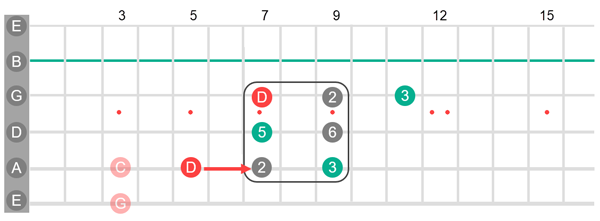
Next, we'll look at minor chord tones using minor pentatonic Freedom Blocks.
Minor Chord Tones
In the minor scale the 3rd degree is moved down one fret. It's called a flat third or a minor third. Minor chords use the first, flat third and the fifth degrees of the natural minor scale. The G minor chord tones are G, Bb, and D.
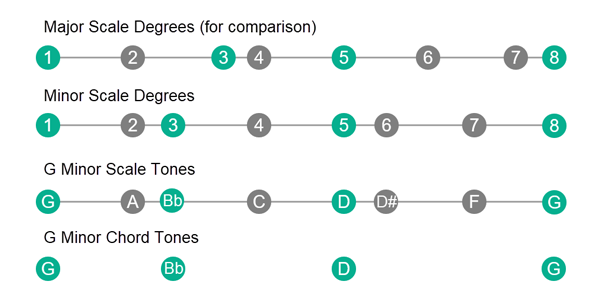
The first minor pentatonic squares below shows the scale degrees. The second square shows the chord tones and the third square shows what you need to remember.

Combining Major and Minor Chord Tones.
Next I'll walk you through all the major and minor chords in the key of C. As each chord comes up in the progression, we'll find the root note on the fretboard and surround it with it with a major or minor pentatonic square.

The chords in the key of C are C, Dm, Em, F, G, and Am. We'll start with a C major Freedom Block. The first chord is C major. Notice that almost all of the root notes in key of C are in this one square. The only one missing is F.
(Notation for C major block: A5-7, D5-7, G5-7)
The next chord is D minor. We'll use one of the D corner notes and create a D minor pentatonic square around the D root. The third row of the square shifts up one fret because it lands on the B string.
(Notation for D minor block: D5-7, G5-7, B string shift B6-8)
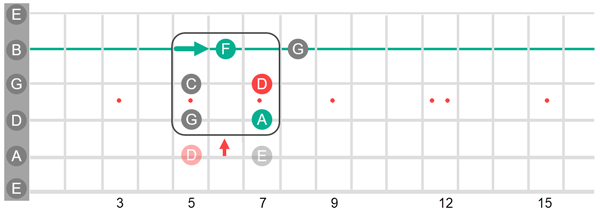
We can move up two frets to get the E minor pentatonic square.
(Notation for E minor block: D7-9, G7-9, B string shift B8-10)
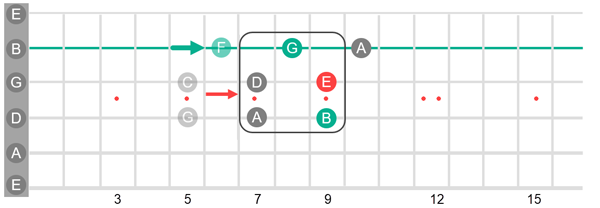
Alternatively, you could move down one string to reach an E minor square.
(Notation for E minor block: E5-7, A5-7, D5-7)
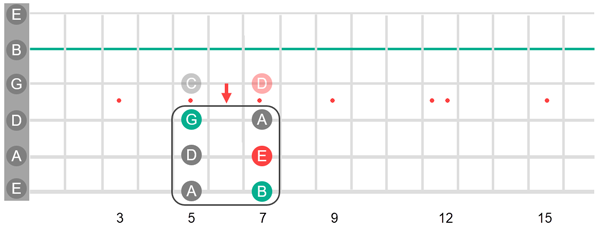
The A minor square is easy because it's the relative minor of C major. It uses the same block as our first C major block. If you emphasize the root and the minor third (C), it will sound like a minor chord.
(Notation for A minor block: A5-7, D5-7, G5-7)
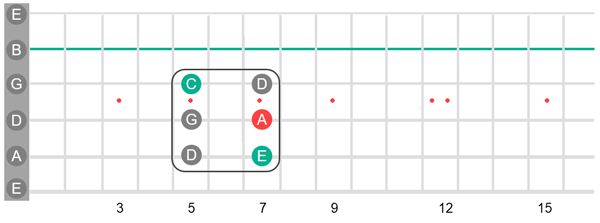
There's no F in our original C major Freedom Block, but we can easily find one. This is the same square that we used for our D minor chord. D minor is the relative minor of F major.
(Notation for F major block: D5-7, G5-7, B string shift B6-8)
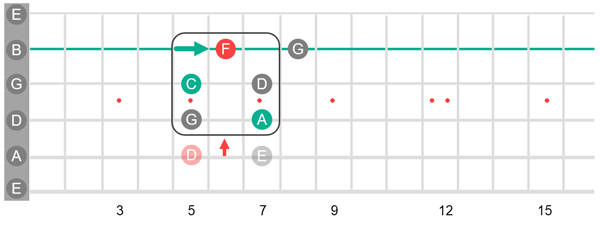
For the G major chord we can move the blocks up one whole step (2 frets).
(Notation for G major block: D7-9, G7-9, B string shift B8-10)

We didn't use rectangles or stepping squares and we pretty much stayed in one place, but you get the idea:
- Find the root of the chord
- Surround it with a minor or major square
- Play the corresponding chord tones
- Use non-chord tones as passing tones
- Move around using additional Freedom Blocks
Adding Rectangles
When you stack Freedom Blocks, you alternate between squares and rectangles. The blocks do not overlap each other. If you're familiar with the CAGED system, you'll recognize this next group of stacked Freedom Blocks. The CAGED system relies on vertical stacking of squares and rectangles.
(Notation: E8, D5, G5, B5-8, E8)
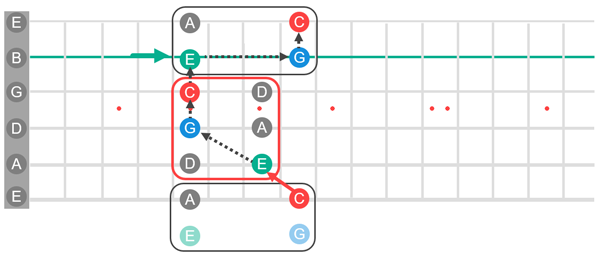
Rectangle bridge the gap between squares.
(Notation: B1, G0-2-5, D2-5-7-10, A7-10-12, E10-12-15, A15)
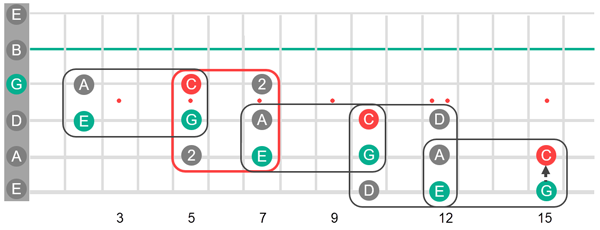
In a similar fashion we could expand our playing surface by using stepping squares. We start with an A minor pentatonic square. Notice the side-step that allows you to jump between groups of stepping squares
(Notation: E5, A3-5-7, D5-7, G5-7-9, shift, B8-10, E8-10-12, side-step, B13, shift, G14
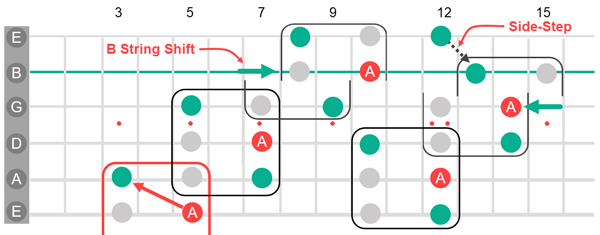
How to Practice Chord Tones
Of course It helps if you can located notes on the fretboard. But blasting the fretboard image into your brain doesn't work unless you have a photographic memory. For the rest of us, I recommend locating all the A notes on the Fretboard. Then create a Freedom Block square around each A note. Try major and minor pentatonic squares. Repeat the process for each of the natural notes, A, B, C, D, E, F, and G.
ChordPulse Lite is a free program that lets you create chord progressions. It takes about ten minutes to figure out how it works or you can watch a video. You can adjust the BPM (beats per minute) all the way down to 20 BPM. Initially you might want to turn down the drums and chords, and concentrate on what the bass guitar is doing.
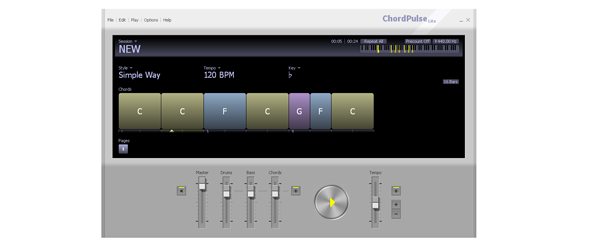
Next Step
The next step is to explore how each of the notes, including the non scale tones, play a part in your improvising. For example, the 3rd plays a huge part in defining major and minor tonality. As the quote above says, each note has a part to play: "fill in space, create tension, or increase interest in the melody."
I recommend these two videos by Ian at Stichmethod.com:
How to find the melody inside a Major Pentatonic Scale
How to find the melody inside a Minor Pentatonic Scale
